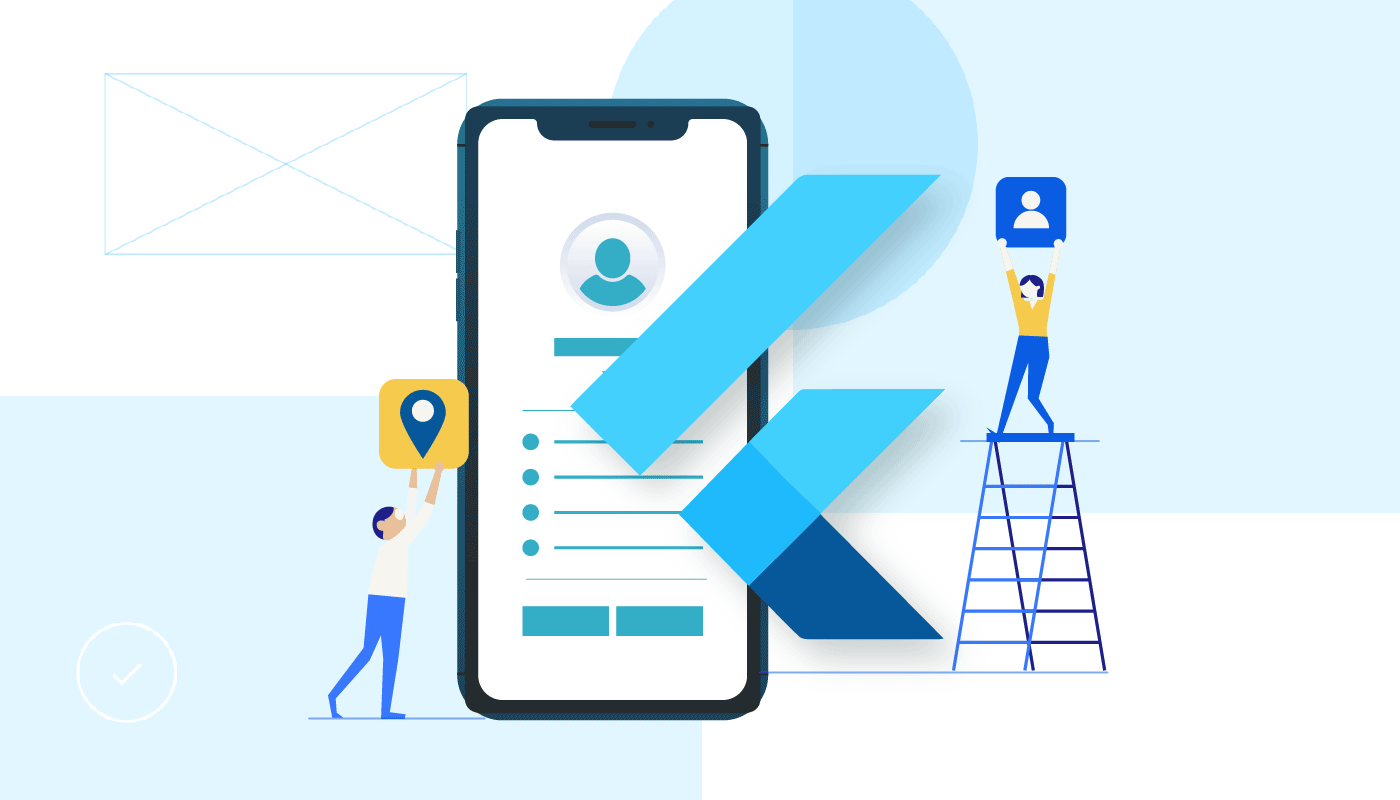The main difference between native, web, and cross-platform development is how they approach app creation and deployment. When you’re ready to turn your idea into a reality and launch a mobile app, the next critical step is selecting the right development approach.
With options like native, web, and cross-platform development available, it’s easy to feel overwhelmed. Which approach will deliver the best app for your needs? This decision can significantly impact your business outcomes, so seeking professional advice from a mobile development agency is essential.
In this article, we’ll break down the key differences between native vs. web vs. cross-platform development and provide clear guidelines to help you choose the best approach for your business.
First, let’s explore the features that make an app great!
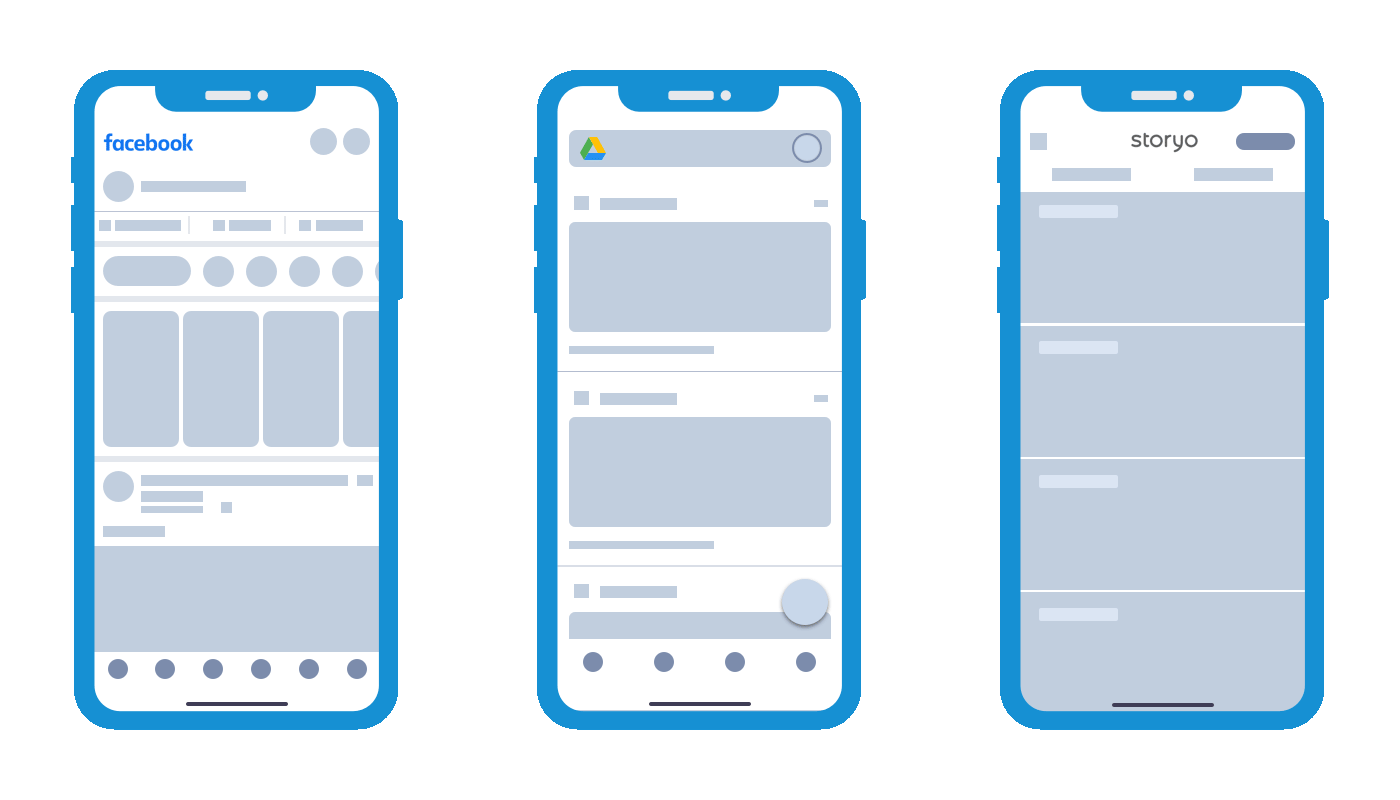
Mobile Development Market Overview
The “app” or “application” has become an inseparable part of our daily lives. Whenever you’re planning a holiday, hailing a ride or looking for a delivery service to order some food, you probably use your favorite apps for all these purposes.
The diversity of apps and app stores will definitely amaze you: Google Play Store, Apple App Store, Samsung Galaxy Store, Sony Apps, Amazon App Store. As for now, there are 2.2 billion apps in the App Store and 2.6 billion in the Google Play Store. While there is a great deal of entertainment apps, you’ll also find lots of business applications designed to improve your operations or add value to companies’ services.
Even with such a diversity, there is also a place for something new. You always have a chance to improve the existing apps or launch a brand-new product that will win the hearts and minds of your target audience.
Customers spend oceans of time scrolling through their phones daily. An average screen time among American adults has been estimated at 3 hours 30 minutes, which is quite a lot, given that there is a share of users who spend even more. Thus, if you strive to gain increased customer engagement, boost sales and expand your digital presence, a mobile app is something you cannot omit.
But having an intention and doing are different things. App development is a sophisticated process which involves many stages and a large team of professionals. So, developing a good and popular app isn’t a piece of cake. Let’s look at specific features that make an app great.

What Makes a Good Mobile App?
Personalized Experiences
Define your target audience or people who are likely to find your app interesting. Think of your potential user, including information about their location, age, hobbies, marital status, and occupation. Developing such a user profile will help you understand what features your app needs to have to be appealing to your target audience.
An app for a French man who works as a trader would differ from the one for a Japanese man who works in a retailing field. Don’t think that you can target the entire world because it equals having no targets at all. So, prior to developing your mobile app, make sure you are fully aware of your audience!
Impeccable Design
It always jumps out at you when it has not been spent much effort on developing an app. Scrappy design reveals it. Most users will not bother themselves to use your app if it has a poor design. At the same time, polished design with elaborated details is a philosophy of an outstanding mobile app development.
Your app has to be easy to use, excluding unnecessary elements that might negatively affect the user experience. Users should not be perplexed by figuring out how one or another feature works. Developers need to put much effort into building a logical and easy user journey. Also, spend more time mulling over the concept of graphics, sound effects, and animations.
Fast and Responsive
Statistical research shows that an average user won’t wait more than 3 seconds for an app to load. Making mobile applications responsive is all about the loading speed as users are getting less and less patient. When you develop your own product, make sure it is responsive enough to attract and retain its first users.
Access to Offline Functionalities
In fact, most apps work with the help of the Internet connection, and only a few of them can be accessed in an offline mode. But the most favorable apps are those that provide offline functionality. When you’re not online, it’s still essential to preserve some functions that work offline. While developing mobile applications, keep in mind this tendency.
Many users tend to scroll through apps while feeling bored, eager to kill time, or having something important to do within an app. For instance, Google Docs allows having access to documents offline. So, you can access these documents even if there are problems with the Internet connection. It gives your app an advantage over your rivals, maintaining positive user experience for your target audience.
Regular Updates
Once your app is launched on the market, it is essential to monitor its performance, listen to your users and provide them with upgrades to meet their needs and wants. And the more effortless the process of updating an app is, the better is the outcome.
Try not to bother your users with unnecessary moves. Building mobile apps that are updated automatically is your way to success. These updates will help to fix bugs, keep content relevant and up-to-date as well as provide your audience with required features.
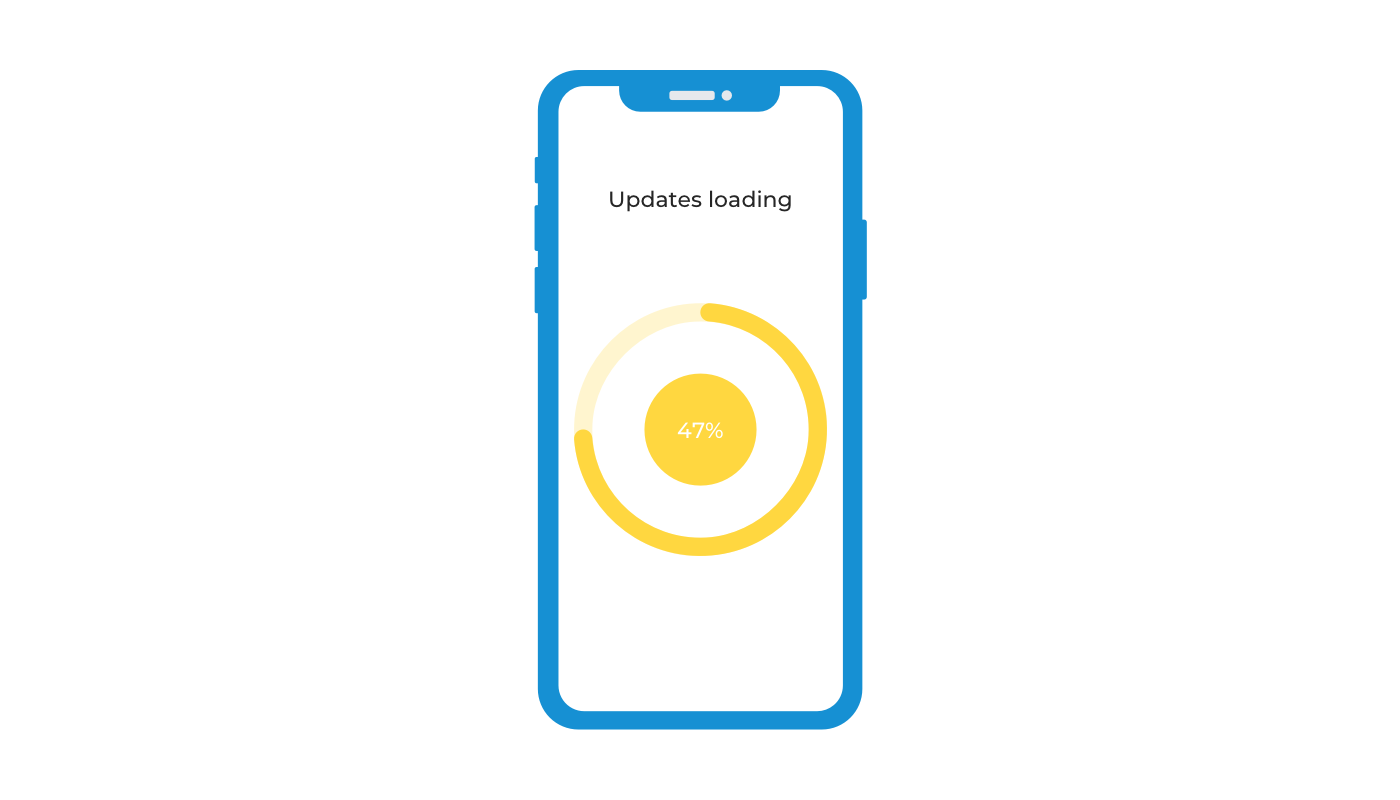
Search Features
Regardless of the app you’re looking to build, don’t forget to endow it with a search bar to reach the content users need instantly. Since good apps are usually teeming with high volume content, users may be bothered by the necessity to search for the content they need.
So, in order not to make your content unusable and burdensome, don’t forget to add this feature to your app. It has to allow your target audience to find content that contains one or another keyword or key phrases.
Social Media Networking
Communication is not restricted to social media apps. Your users might have a need to interact with customer service employees or other users depending on the nature of your business.
Collaborating and communicating is what social networking can give. If you want to build a great app, it is vital to ensure a good level of interaction available directly through your mobile application. So, whether it is a social network, media sharing networks, forums, or online reviews, providing reliable communication channels will boost your customer loyalty and increase the overall engagement rate.

User Feedback
Your app can seem impeccable, but be sure it can become even better if you let your users leave feedback. Just asking users what they think about your app will provide you with a bunch of insights. Feedback is a great way to find blind spots that will improve the app and boost the satisfaction rate.
What can you do to improve your business? Just add a feedback button, and you will be impressed with a number of useful ideas users will come up with. Such functionality is relatively easy to add, but rest assured it will surpass the expectations. It’ll show you what you need to add, change, or fix to further scale your business.
Animation
Since habit and muscle memory rules us, animation is a rising trend that is likely to dominate the app development market in the coming years. The best apps maintain real-life experience with the help of an animation, making users interact with objects. Animations enhance interactivity and boost user experience.
A user touches a screen, and it responds with an appealing animation. It helps submerge your audience into the digital environment. Thus, by adding stunning, realistic, and meaningful animations, you’ll ensure your app’s success. If you go the extra mile by providing a bit of interactivity to your users, you can be sure this step will be paid off in the future.
User Privacy and Security
Users become more and more concerned about privacy and security. Thus, you should be even more careful while sharing their personal information with third parties. With the rapidly increasing number of frauds, the importance of keeping the users’ sensitive data private becomes more paramount than ever before.
Payment details, the user’s preference, messages and other information is what you should care about. If you let this data leak, you might undermine the trust of your clients and damage your reputation. An app with an excellent security level is written with a secure code, has all data encrypted, and uses only authorized APIs.
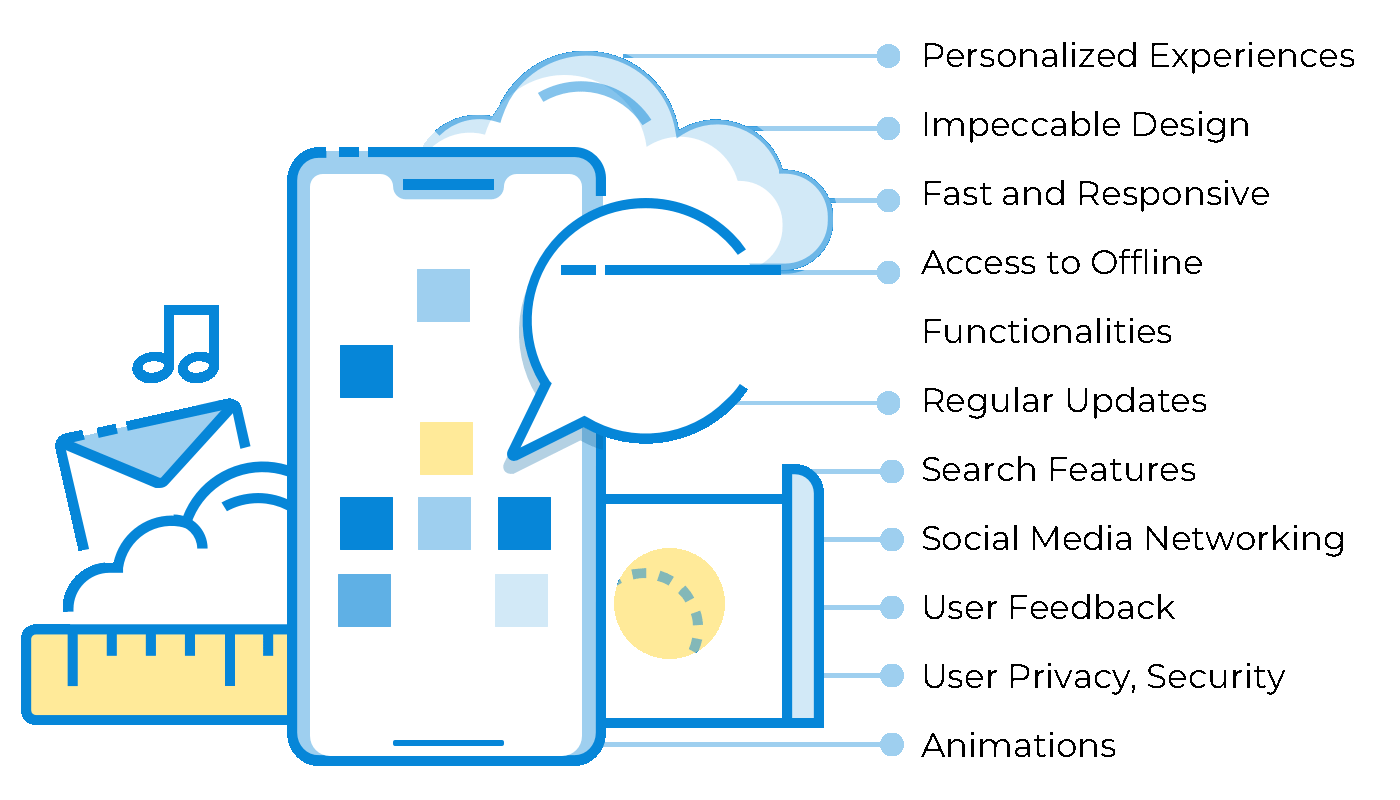
Tradeoffs for Choosing the Right Development Strategy
How to make mobile applications efficient, successful, and favorable? The key to creating such an app lies in the strategy you choose to develop it. It’s known that the most trending apps are simple, flat, and have eye-pleasing UI.
But if you look at the most popular app markets, such as the App Store or Google Play Market, you’ll find a lot of apps that match these criteria. So, businesses need to put much effort into making their software products more competitive. To develop a strong strategy, pay attention to what you have and what you can make out of it. Let’s look closer to points you need to elaborate before getting down to the app development process.
Performance
First of all, you need to decide which app performance you’re striving to reach, and consequently, determine what type of app you want to build. For instance, it’s a well known fact that native and hybrid apps demonstrate impeccable performance. Obviously, there is a set of pros and cons about each mobile development approach .
Thus, while developing mobile apps that will stand out in such a competitive landscape, your task is to set clear goals and decide what you’re striving to reach in the end.
Apart from setting clear goals in your project, you need to decide how many resources you are ready to invest in your product. Understand whether your app needs to be impeccable with fast performance and delve more into the limitations and opportunities of each framework, such as React Native, Flutter, and others to find out which tech stack best suits your needs.

One of the deepest pitfalls you need to avoid is believing that one or another mobile app platform is easier or the best. The truth is that each of them has its own peculiarities. You’ll benefit from it only in the case you properly distribute and organize the resources you have.
There is a potential pitfall you’re likely to face in the case you’ll rely too much on full-stack developers. They have a broad base of knowledge, but they may not be aware of the primary peculiarities of an app building platform you choose for your project.
Instead of reinventing the wheel, the best option here is to hire a sector-specific team that will save you much time and effort. Hence, it is always better to rely on first-class professionals with relevant experience and expertise in the latest technologies. LITSLINK has a vast pool of software engineers capable of meeting any of your requests.

Development Time and Reusability of Code
Development time is one of the factors you’ll have to consider in the app building process. Most businesses try hard to reduce that time as much as possible to be the first to launch their product first on the market and outpace competitors.
There are a few options you might consider to increase the development time. First, you can scale your team of software engineers who’ll be able to build your product faster. But in this case, you should be ready to allocate more resources to your project.
It’s also known that cross-platform frameworks allow shortening the development time thanks to the reusable code. So, if it’s critical for you to finish the development process within a short time frame, pay to this mobile development approach.
Future Upgrades
Mobile apps development niche doesn’t stay at the same place. It constantly evolves, which means you should always keep an eye on the latest trends and focus on the most important aspects.
If you want to sustain your app’s life on the market without a major rewrite, it’s needed to develop clear upgrade paths. You might test your product with a group of users, get their feedback on work on your full-fledged product to avoid rewriting your app from scratch. So, while making mobile applications, ensure that it’ll be easy to scale your app with new features.
Cross-Platform App Development
What is Cross-Platform Development?
“Write once, run anywhere” is how we can describe cross-platform apps briefly. As you can understand, this type of application can be used on various platforms, and you don’t need to write a codebase for each of them. For cross-platform apps, you create a single codebase that works on many platforms regardless of the OS you choose, whether it’s Android, iOS, Mac, Linux, or Windows.
To build a cross-platform app, developers use multiple tools and frameworks such as React Native, Flatter, PhoneGap, Unity or any other cross-platform technology.
Advantages:
- Reusable and Shareable Code
Up to 80% of a codebase for cross-platform applications can be reused and adapted for a variety of devices. It facilitates the work of developers and increases the speed of app development.
- Cost- and Time-Effective
Since a single code is shared among different devices, there is no need to hire a large team of developers. Reusable code reduces the time spent on development and makes the process much easier. The development team does not have to spend too much time rewriting code or writing it from scratch; they just adjust a code to a particular platform or device.
- High-Quality UI/UX
A cross-platform app has an impeccable UI & UX design that performs consistently across different platforms. Importantly, to create such high-quality UI and UX, developers resort to native controls. Although cross-platform apps don’t support all native modules, you address the community to find a solution.
That’s why design performance is similar to that of native apps. Thus, cross-platform apps are fast, responsive, and eye-pleasing.
Disadvantages:
- Lack of Native Modules
Since software development is quite an intricate process, your team might face a number of issues that cannot be easily resolved with the technology you choose. Thus, software developers might need to insert the parts of native code in the codebase, which means you might end up having two codebases instead of one. Fortunately, such cases do not often appear.
Besides, keep in mind that to build genuinely awesome cross-platform applications, you’ll need to hire developers who also have some knowledge about native development. Fortunately, software engineers at LITSLINK have vast expertise in both development approaches, which means they are both great at cross-platform and native mobile development.
- Lack of Updates
It is often the case that the cross-platform framework you use might not have all the features supported by the operating system. For instance, if Apple provides access to Apple Health that allows your app to analyze the user’s data and count the number of steps he/she makes, etc., cross-platform apps might require a bridge for the same purpose.
- Lack of 3D Support
Cross-platform software might not enjoy the full spectrum of 3D graphics, which can be frustrating to some users. Thus, if you consider building an application with eye-catching design and impressive graphics, you might need to build a bridge to native modules, libraries, or engines, such as Unity.
Cross-Platform Mobile Development Tools
Since cross-platform apps can be run on different platforms, you need to find proper and effective development tools that will allow building the same great app for both Android and iOs. To create an awesome app, you need first-class cross-platform solutions. And React Native and Flutter have proven to be best and reliable cross-platform technologies with a demonstrated history of successful projects.
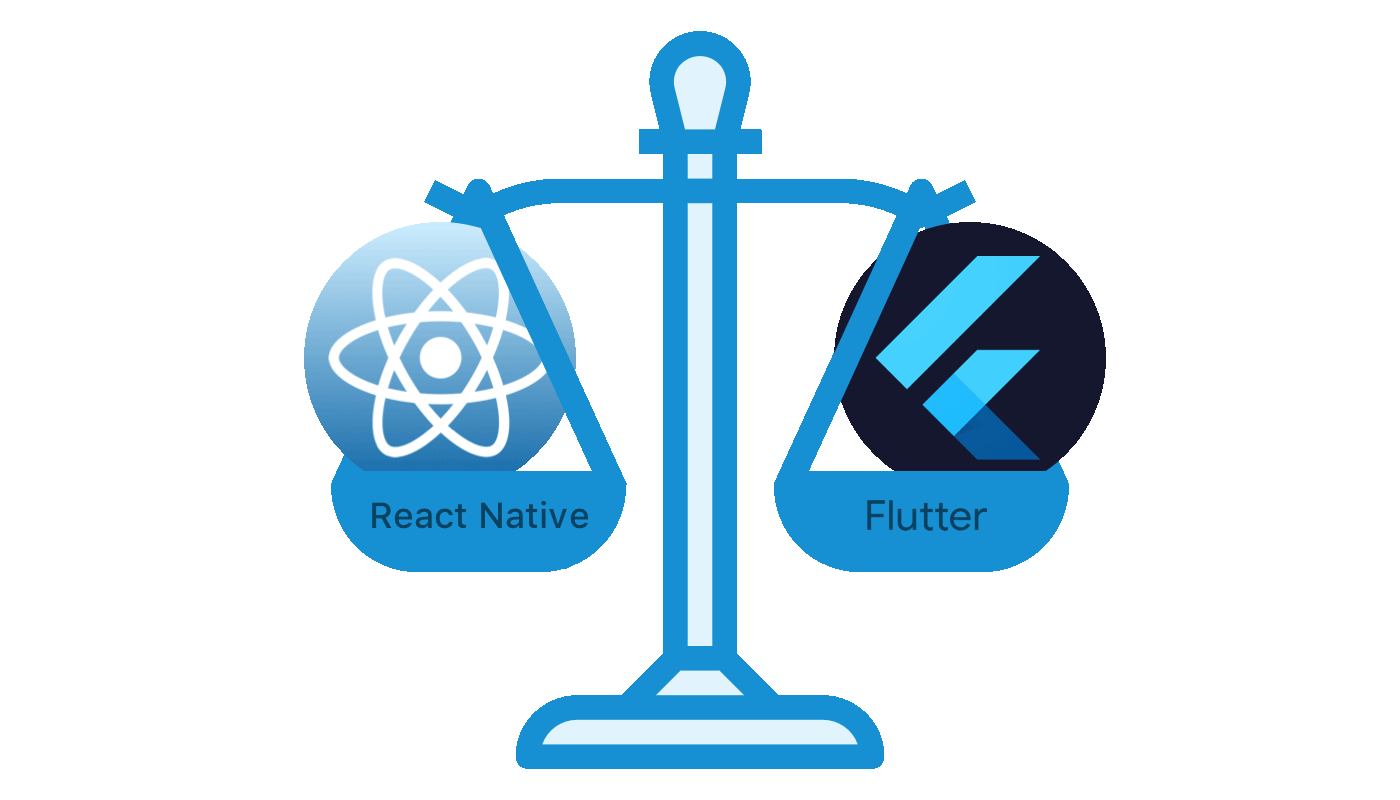
React Native is frequently used to create a cross-platform app that will be run both on Android and iOS using a single framework. Being a child of Facebook, this framework is based on a React library to build user interfaces. With React Native, developers can write readable and clear code faster, which is easy to debug.
Sooner or later, React Native promises to provide that feel and look as native, so users will hardly differentiate them. Most of the elements can already be written to reflect native ones. The community is growing and more and more solutions appear to strengthen the performance of RN apps. Thus, if you’re looking to build an appealing and high-performing app to reach a broader audience, React Native can make an excellent fit for you.
Flutter
It’s another the same effective and useful cross-platform app framework. Flutter utilizes such programming language as Dart, which allows writing clear code for both Android and iOS. It has strict typing, which consequently facilitates maintenance and code debugging.
Flutter has its own widget library used to build a great variety of animations that are used for UI. It guarantees high-performing and appealing UI, and it allows developers to make universal UI appearance no matter which OS version is used.
What’s more, Flutter offers an innovative layout structure stating that each widget can be simpler, and every object can be turned to a widget. In such a way, it allows faster rendering. Flutter’s toolkit also guides developers through every aspect of the app development process, improving the outcome.
Examples of Cross-Platform Apps:
Instagram, Facebook Ads Manager, Storyo, Skype, Wix, The New York Times, Adobe Flash player, Skulls of the Shogun, CitiBank Network Direct.
Web Mobile App Development
What is Web App Development?
What’s the difference between websites and web apps? It’s an everlasting question that perplexes a lot of minds of those who are not deeply acquainted with the niche. The main difference is that web apps cannot give as much information as websites. A website is more an information resource, while a web app is the same website but with functionality and interactive elements. Apps’ focus is narrow. However, both websites and web apps run inside Chrome or Firefox or any other browsers.
One of the features that also differs web apps from native apps is that users can only perform most of the tasks with the help of the Internet. Besides, web applications’ front-end is written with JavaScript and HTML, which are browser-supported languages, and back-end is written with Java and Python. You usually need to take more steps to open such an application, but you can use it with any device, whether it’s Android, iOS, or PC.
PWA, aka Progressive Web Apps, is an advanced version of web apps. PWAs tend to be more advanced than web apps. One of their perks is that they provide you with the possibility to do tasks offline and have expanded access to the device’s functionality.
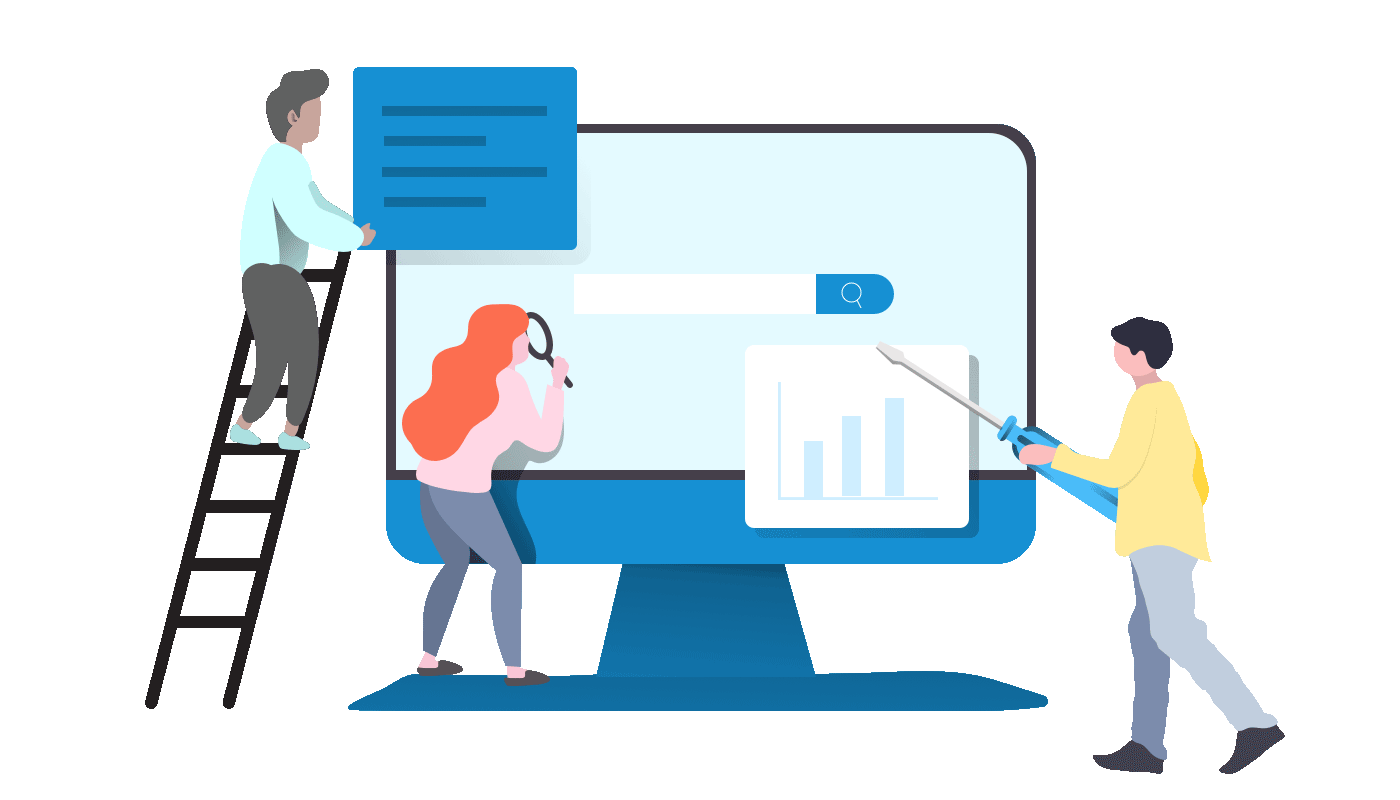
Advantages:
- Simple in Development
Usually, C# or JavaScript or HTML is all you need to develop a user-friendly web application. These programming languages used for mobile app development are known to have a mild learning curve. Besides, you don’t need to write several codebases. Write it once and open in any browser. Also, web applications do not require much planning and development compared to native apps.
- Lower Cost and Timing
Developing web apps takes less time and money. It is easier to find a small team of web professionals who will create a striking app quickly and at a good price. So, if you’re on a budget, web app development will make a great match for you.
- Available on Every Device with Internet Connection
Web apps do not require writing several codebases for different platforms. Developers write code only once for web browsers, and regardless of the device you use, you can easily access this app. All you need is to be online.
- Easily Updatable
Web apps allow developers to make short releases once the product is launched on the market. If you’re in a rush, you have an option to create an MVP and scale it further depending on your users’ needs. Small changes won’t require users to update an app through an app store since it is updated automatically for every user.
Disadvantages:
- The Quality of A Web App Depends on A Browser
In general, web apps can also brag about their stunning UI and UX design and relatively excellent performance, but it’s so good until you use a particular browser. There are a number of browsers, including Safari, Chrome, Firefox, Opera, Microsoft Edge out there, which might display the web app differently. When you open the app in Chrome, it works perfectly well, but the moment you switch to Microsoft Edge, it may work totally wrong.
- Not Very Convenient in Operation
The overall user-friendliness and comfort of using the website are lesser than in case with native or cross-platform apps. It’s easier for users to use an app for a variety of purposes, such as communicating with other users, posting photos, or even doing business or processing financial operations. Besides, web apps have limited offline support. Thus, you cannot have access to it when there is no Internet connection.
Web App Development Tools
Web application tools can help you build new impeccable products in the mobile market. Choosing the right framework is a shortcut to a successful web application. It is critical to select the right tech stack because frameworks define a lot of things, including how much time you’ll spend on your project, how effective your app will be, what app performance you’ll gain, its scalability, and many others. So, let’s look at some of the most reliable frameworks and tools to create a fantastic web app.
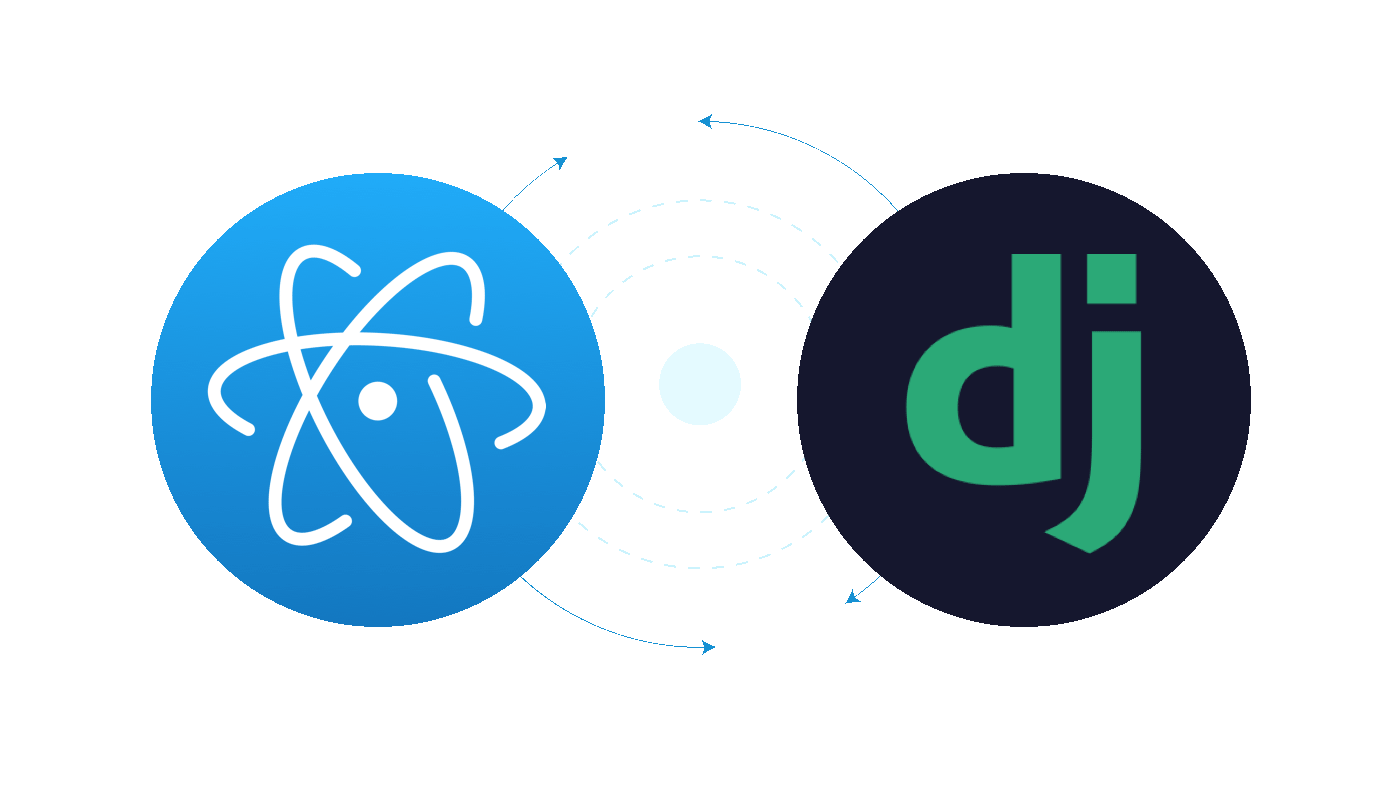
React
React is a JavaScript library for building interactive UIs. This technology enables developers to build dynamic and responsive web applications as it requires less coding and provides more functionality compared to its rivals. JavaScript Syntax Extension (JSX) and Virtual DOM are the two core features that make this JS library so appealing for software engineers.
Django
Django is a framework that uses Python, which is a leading mobile app development language. This top-rated framework increases the development speed and promotes well-organized software design.
It’s one of the most reliable, secure and fastest tools to build an app. You’ll find many useful utilities and packages within Django, which aim at simplifying the development process.
Angular
Another popular framework for creating web applications is Angular. It’s a product of Google and it is perfectly suitable for creating cross-platform applications.
But it is not restricted to cross-platform development only as it allows creating stunning web apps as well. Angular’s speed and performance is what makes it so valuable. It works well with big data and allows building huge data models so you can take control over scalability. It also delivers a wide range of instruments for building really recognizable web apps, such as a UI component library, code templates, code completion, and code editor.
Examples of Web Apps:
AliExpress, Forbes, Pinterest, OLX, Twitter Lite.
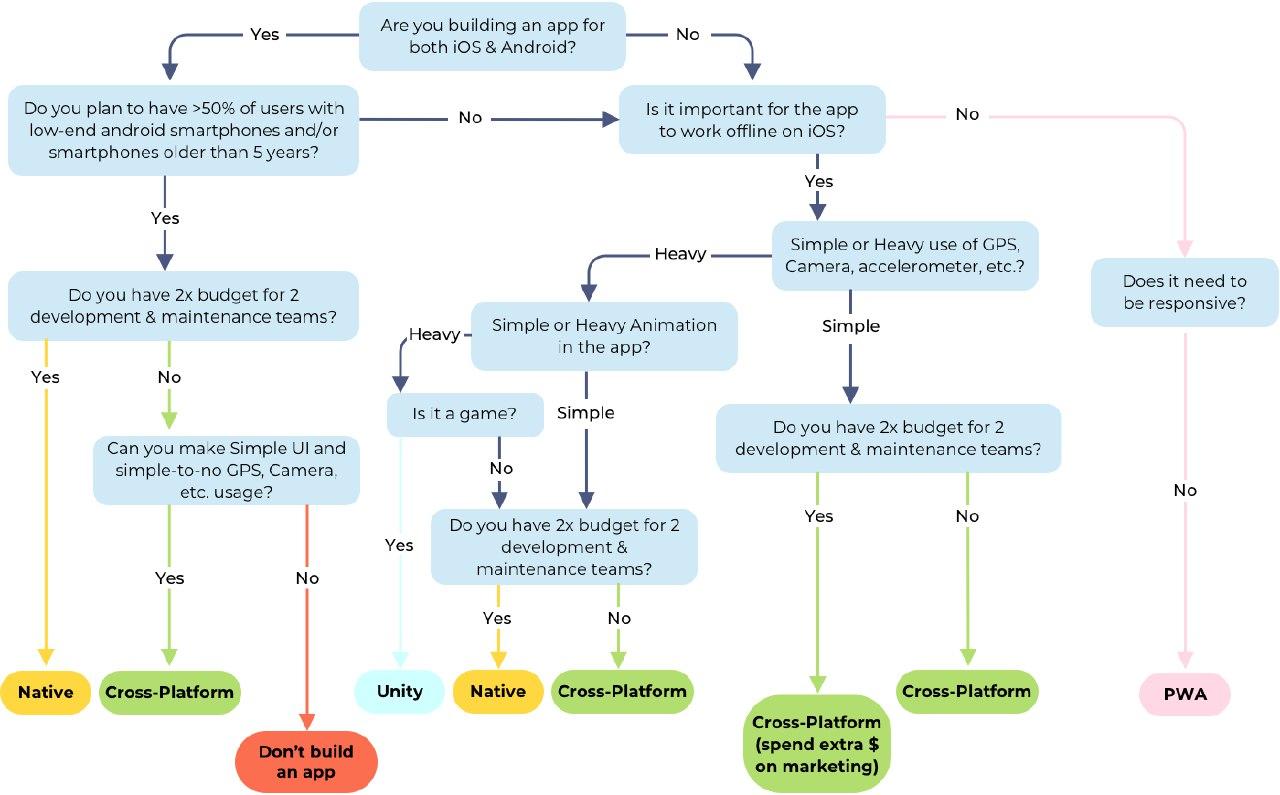
Native App Development
What is Native Development?
What’s peculiar about native apps is that they’re developed for a platform of your choice that allows creating a better user experience. Yes, it means that app developers have to write two different codebases in case they’re going to launch an app on two platforms. Each of the platforms has its distinctive characteristics.
For instance, for iOS app development, software developers usually use Objective-C and Swift, while native Android applications are written in Java or Kotlin. Usually, native apps tend to demonstrate striking performance, but you should keep in mind that they also have a number of drawbacks which need to be considered before you make the final decision.
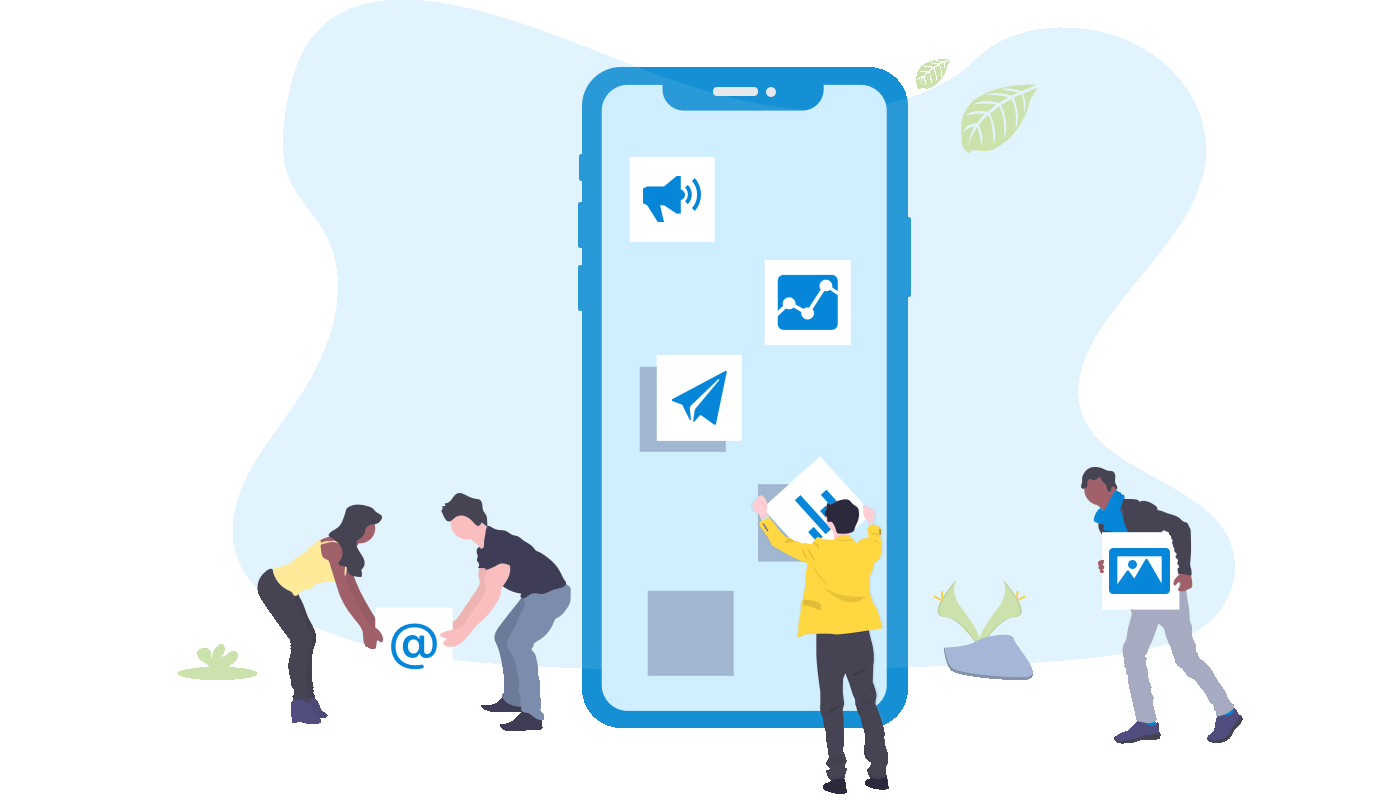
Advantages:
- Facilitated Integration And Compatibility With Devices
Due to the fact that native mobile apps are written for a specific platform, they fit it like a hand to glove. It means that cameras, microphones, and GPS are easily and effectively synchronized within an app, which allows using the capabilities of your product to the fullest.
- Outstanding Performance
Native apps are fast and responsive. They have been called a golden standard for a long time. It happens so because the product is developed precisely for a specific platform and adapted to its peculiarities. That’s what makes them so superior. Thus, when you opt for high-end iOS or Android development services, you’re sure to get an outstanding performance.
- Eye-Catching UI/UX
Native mobile apps normally have an appealing interface which eases interaction between the user and your product. It’s just because they follow particular design guidelines. They are different for each platform. For iOS, developers follow the Human Interface Guidelines, and for Android, they adhere to Material Design. And as a result, they get an intuitive design. These guidelines are Ariadne’s thread that helps keep interfaces and navigation simple and more familiar to users.
Disadvantages:
- You Need to Write Code for Each Platform
Native apps work only on one specific platform, and native code cannot be shared with any other platform. In case you want to scale your business and launch your app on another platform, developers might need to create another app with a different codebase. And that is usually a time-consuming and expensive process.
- Two Times Higher Development Cost
Since you need to write different codebases for different platforms, you will need two separate teams of software engineers to create and maintain your product, which means you’ll go into extra expenses.
Indeed, native applications are complicated and intricate products, and to develop them, you should find a highly-paid professional team. So, be ready that it’ll cost you a little penny.
- Two Times Higher Maintenance Cost
Why is the price for native apps higher? It’s because you build a native app for each platform separately.
Native development comes with higher maintenance costs. Thus, if you decide to scale your business and launch your app on another platform, you might need to build a new app and maintain the two of them. Such a process is pricey, difficult and time-consuming.
Native App Development Tools & Technologies
To create a native app, engineers use one of the native programming languages. These languages include Java or Kotlin for Android, and for iOS, they may use Swift or Object-C.
Since native apps are known for demonstrating exceptional performance and impeccable UX, engineers need to access all of the device’s feature set to reach such brag-worthy results. But to have access to such sets and leverage advanced functionalities in the app, they need to use special tools. Let’s look at some of the top tools used for creating native apps.
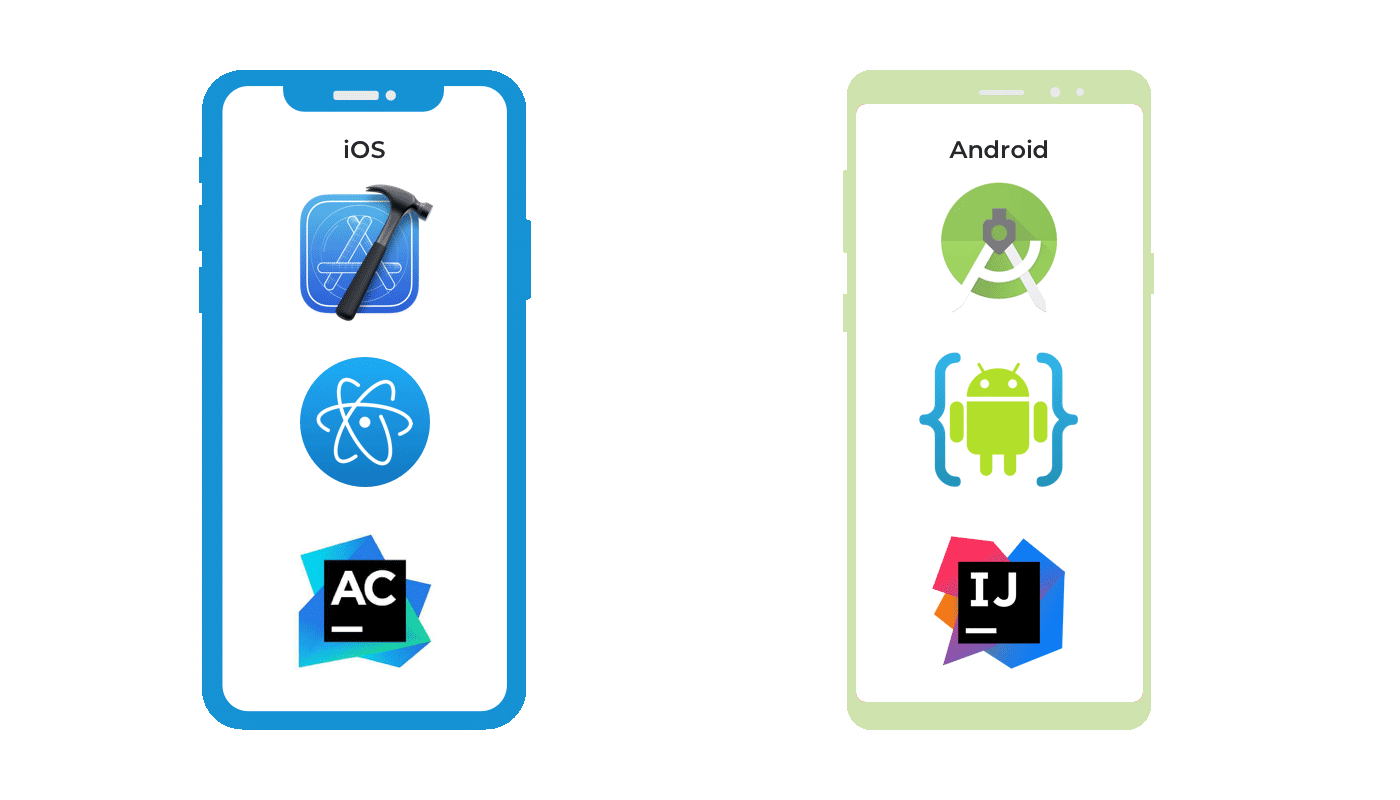
For iOS:
Xcode
Many iOS applications have been written with the help of Xcode. Xcode is an IDE or Integrated Development Environment that contains software development tools specially designed for macOS, iPods, iOS, tvOS, and watchOS. This IDE provides engineers with Command Line Tools (CLT), consisting of everything needed for creating a native iOS app.
Xcode allows transforming code easily, and enables engineers to build their own instruments. Besides, it easily complies with code at a higher speed, which makes mobile app development a bit faster. Xcode also comes with an IDE source editor, detailed documentation, system data recording, and integrated build system.
AppCode
Another reliable tool for building native mobile applications is AppCode. This IDE helps you eschew extra coding providing coding assistance, including live templates, code formatting, and code compassion features. It natively supports a great variety of programming languages used for app development such as Swift, C++, Objective-C, JavaScript, and so on.
Coding assistance with code completion, code generation options, live templates, code formatting, multiple carets and selections, automatic insert of imports and imports optimization.
Besides, it provides you with various testing frameworks, including Google Test, XCTest, Kiwi, Boost.Test, and Quick. AppCode has Code Analysis Refactorings and Build-in tools and integrations.This tool is also good for automation of routine tasks, detecting and fixing errors, and boosting overall productivity.
For Android:
Android Studio
This tool provides an implementation editor, drag and drop features for the layout, and helps make shortcuts in coding and design. Android Studio allows you to use the NDK, which is a toolset for implementing your app’s parts in native code with the help of C and C++ mobile apps development languages. Hence, Android Studio comes with plenty of opportunities for developers and equips them with handy tools, impressive resources, and plenty of vital features.
Android provides guides, the editor with tons of useful features such as error-checking tools, code complexion instruments, and code navigation. This software aims to help you create first-rate mobile native apps for Android. It is teeming with useful features, and visually, it’s very appealing.
Interestingly, AIDE is an application itself, and it allows developing native Android applications right on your Android device.
Intellij IDEA
IntelliJ IDEA is also an integrated development environment. It offers a range of features such as code complexion and plugin ecosystem. With its help, you can easily edit, run, debug, and maintain your Native app. And cleaver and user-friendly coding assistance are likely to make this process enjoyable.
What is peculiar about IntelliJ IDEA is that it gives intelligent and fast experience, offering wise code complexion, instant code analysis, and solid tools. A great number of frameworks and languages are supported by Inellij, which is a great bonus. It is a base platform for tons of IDEs of JetBrains company, such as Android Studio, AppCode, WebStorm, etc.
Examples of Native Apps:
Google Maps, Twitter, LinkedIn, Telegram, Facebook, WhatsApp, Artsy, Pinterest

So, Which Mobile Development Platform to Choose?
Each type of mobile development is good. Your choice will depend on your business goals, budget, deadlines, the number of features you are going to include, etc. You can also read about how to launch your mobile app here in more detail.
We believe this article has helped you sort things out and explore all the pros and cons of native, web, and cross-platform development.
The next stage is finding a reliable software development company in the US with a team of experienced tech specialists. Great works reflect great expertise. To pick professional developers, you need to get acquainted with their previous works.
Take a look at LITSLINK’s successful outsourcing case studies. If you’re looking for a vast pool of software engineers specialized in first-class web, iOS, and Android app development, we are here to help you!
Reach out to us and speak out the idea of your new great project to a team of real experts!



